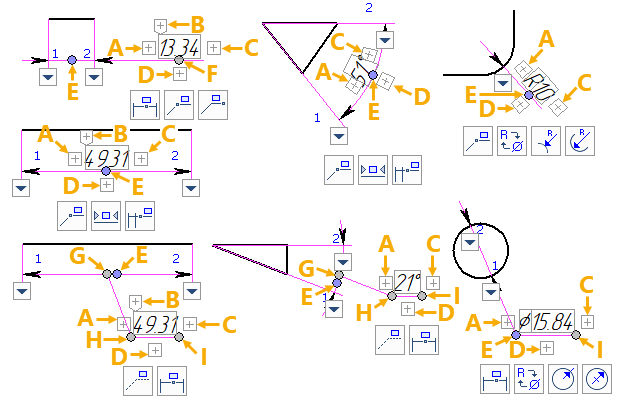Manipulators of Dimension |
  
|
Markers, manipulators and buttons for quick editing of a dimension are displayed, upon selecting a dimension in drawing or in 3D scene, as well as upon moving the cursor over a dimension in drawing. Click ![]() a manipulator or a button to perform a corresponding action. Manipulators look like the small colored circles
a manipulator or a button to perform a corresponding action. Manipulators look like the small colored circles ![]()
![]() , whose color changes to orange
, whose color changes to orange ![]() , upon moving the cursor over them. Buttons have different appearance depending on their purpose.
, upon moving the cursor over them. Buttons have different appearance depending on their purpose.
Buttons can be disabled by disabling the Show toolbar with options checkbox located at the Options tab of the Dimension command's parameters window. Manipulators and markers are displayed regardless of the state of this checkbox.

|
1 |
Starting point of measurement marker |
|
2 |
Ending point of measurement marker |
A |
|
Add text before value Invokes the text input toolbar More info is available in the Text Strings within Dimension section |
B |
|
Add dimension symbol Invokes the symbol selection toolbar More info is available in the Style of Dimension section |
C |
|
Add text after value Invokes the text input toolbar More info is available in the Text Strings within Dimension section |
D |
|
Add text under value Invokes the text input toolbar More info is available in the Text Strings within Dimension section |
E |
|
Change position of dimension line |
F |
|
Change length of leader line |
G |
|
Change starting point of leader line with shoulder |
H |
|
Change position of leader line's shoulder |
I |
|
Change length of leader line's shoulder |
When using |
||
|
|
Change arrow appearance Invokes the arrow parameters toolbar More info is available in the Arrows of Dimension section |
|
|
Center dimension text |
|
|
Place leader/Remove jog |
|
|
Place jog |
|
|
Dimension with jog |
|
|
Hide jog |
|
|
Remove jog |
|
|
Transform to radius/Transform to diameter |
|
|
Outside circle Places arrow of radius dimension outside selected circle
|
|
|
Inside circle Places arrow of radius dimension inside selected circle
|
|
|
To opposite side Places arrow of radius dimension inside selected circle
|
|
|
With one arrow Makes dimension line of a diameter similar to the one of radius,
|
|
|
With notch Makes dimension line look similar to what the previous button does,
|
|
|
With two arrows
|
Manipulators listed above are common for dimensions of various categories. Additionally, some categories of dimensions have their own specific manipulators described in sections describing methods of creating such dimensions.
Text input, symbol selection and arrow parameters toolbars can be moved. To do so, move the cursor over left side of a toolbar ![]() . Then the
. Then the ![]() icon will appear near the cursor, which means, that you can start dragging the toolbar, while holding
icon will appear near the cursor, which means, that you can start dragging the toolbar, while holding ![]() pressed.
pressed.
Moreover, clicking a dimension value with ![]() invokes the value input toolbar
invokes the value input toolbar ![]() , where you can type in a new value via keyboard. The Set "Driving" parameter when editing checkbox is enabled by default in system options (Options > Constraints and dimensions > Create Dimensions Automatically). In result, any 2D dimension automatically becomes a driving one, when the user manually changes its value this way. The value input toolbar may also be dragged with mouse upon moving the cursor over its left side
, where you can type in a new value via keyboard. The Set "Driving" parameter when editing checkbox is enabled by default in system options (Options > Constraints and dimensions > Create Dimensions Automatically). In result, any 2D dimension automatically becomes a driving one, when the user manually changes its value this way. The value input toolbar may also be dragged with mouse upon moving the cursor over its left side ![]() . When dragging, the cursor changes appearance to
. When dragging, the cursor changes appearance to ![]() .
.